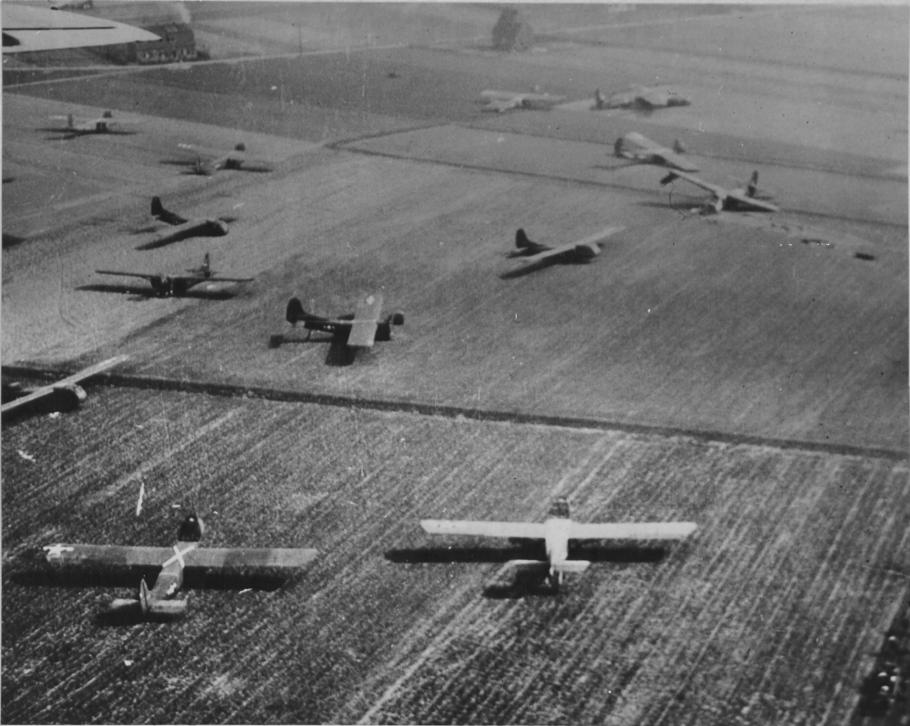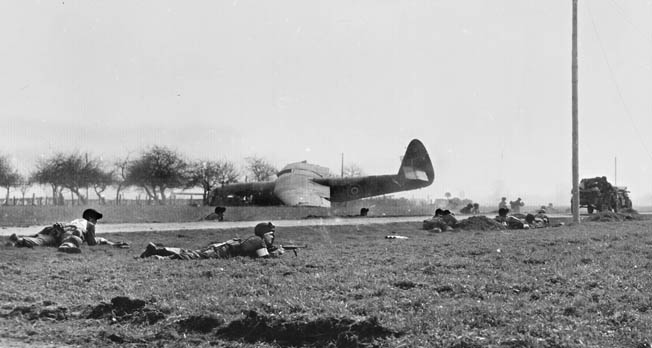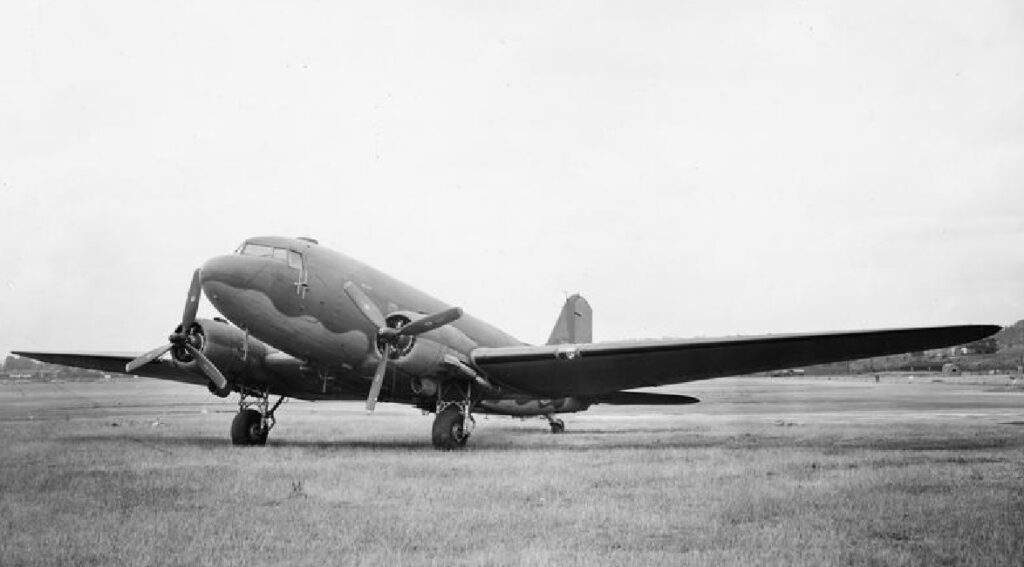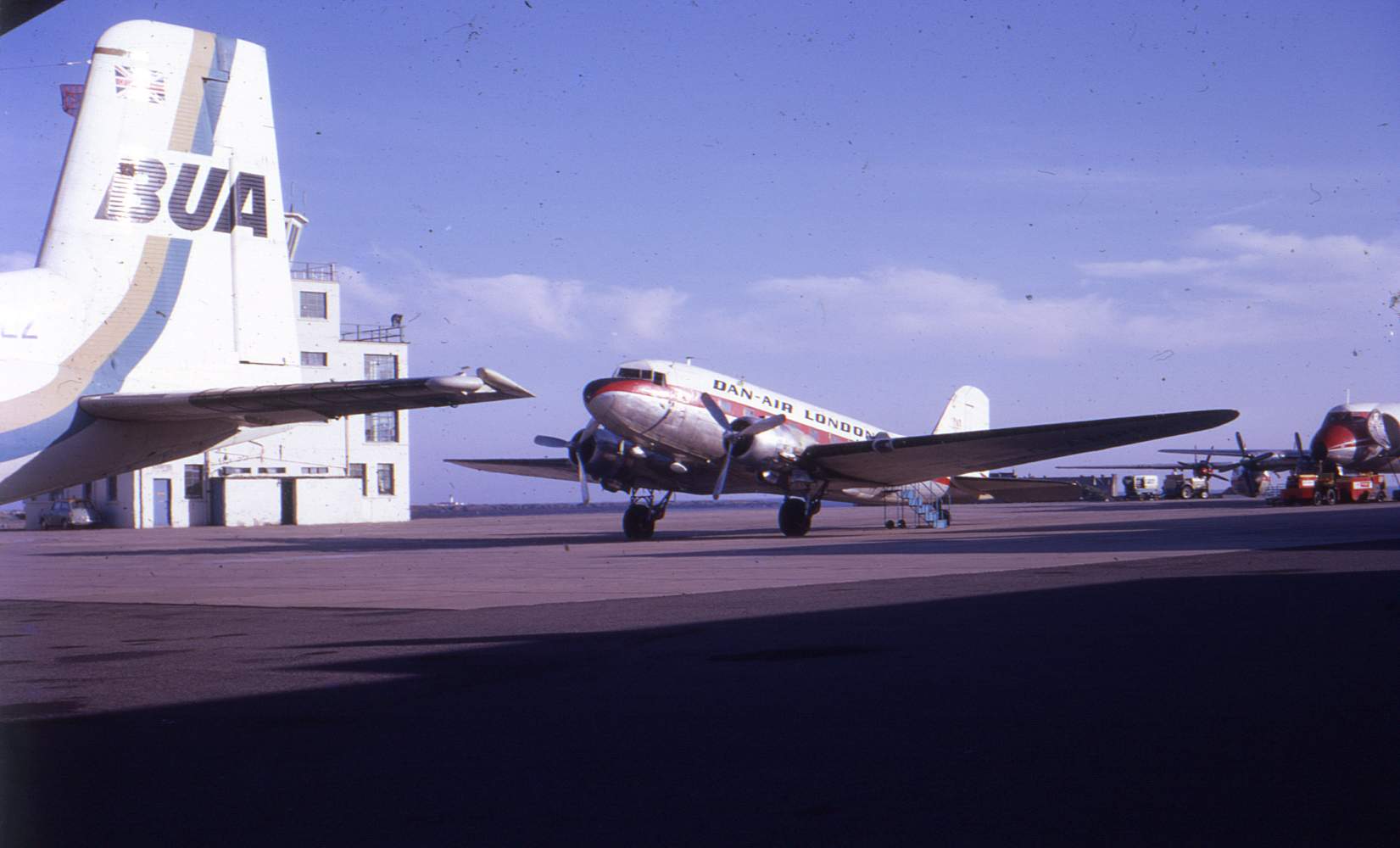233 Squadron had taken place in the great Northern European airborne operations of WW2, Operations Overlord and Market Garden and had participated in smaller-scale supply-dropping support missions. Along with fellow 46 Group Transport Command Squadrons, 233 would play an important part in the last great airborne armada – the Rhine Crossing.
The 46 Group Dakota squadrons were based at Cotswold airfields but, for Operation Varsity, they were to fly from Essex airfields. The Broadwell-based squadrons of 512 and 575 and Down Ampney’s 271 Squadron all moved eastwards to Gosfield aerodrome while Blakehill’s 233 and 437 squadrons plus 48 Squadron from Down Ampney transferred to Birch airfield. Troops of the British 6th Airborne Division had begun to move to the Birch area on March 17th and this was to be the first operation for an airfield which had been woefully underused since construction in late 1943/ early 44. Other nearby airfields accommodated 38 Group Stirlings at Rivenhall, Great Dunmow, Shepherds Grove and Matching, Halifaxes from Earls Colne and Woodbridge plus USAAF C-47s at Boreham, Wethersfield and Chipping Ongar. The 46 Group dedicated to the operation proceeded to their East Anglian locations on March 22nd and commenced preparations. Briefings took up the entire day on March 23rd ready for action the following morning.

The morning of March 24th dawned clear and fog-free. The twenty-four 233 Squadron Dakotas were led by Wing Commander K.Mellor in KG315. The first take-off was at 06:18 and all aircraft/ glider pairs were airborne by 06:49, heading south-east towards the first rendezvous point, Altair, near Folkestone. With visibility of more than 12 miles, the huge job of marshalling of the UK-based squadrons progressed well. From Folkestone, the armada continued south and east across the English Channel, passing waypoint Beta before turning north east at Gemini and progressing via Marfak, Vega, Kingston and Yalta North to the landing zones. The entire fleet of around 1800 USAAF transports and gliders and 1123 RAF transports/ gliders (1) was supplemented by 889 escort fighters (2) and, when fully assembled over Brussels, was over 200 miles long and is often quoted as taking over two and a half hours to pass overhead.
(1) Stephen L.Wright, in his book ‘The Last Drop’, quotes 226 USAAF C-47s and 72 C-46s dedicated to carrying paratroops, 610 USAAF C-47s towing 906 gliders plus 1123 RAF aircraft, total 2937. Some sources give an RAF contribution of 1128. Martin Bowman in his book Air War Varsity gives 541 paratroop transports, 1050 tow aircraft and 1350 gliders: total approximately the same at 2941.
(2) Although 889 is the figure generally quoted for escort fighters, a further 2153 aircraft, including Spitfires, Typhoons, P-51s and P-47s, are likely to have been involved in ground support operations. Data from www.ww2db.com article by C.Peter Chen.

The Varsity operation was the largest ever single airborne drop and was judged to be a success despite some setbacks. The airborne operation delivered around 20,000 troops during daylight and, for the first time, at the same time as the main ground-based offensive. By the end of the operation, around 80,000 British and Canadian troops were across the Rhine and on their way to Berlin. Some of the Waco CG-4A gliders were double-towed by tug aircraft but 233 Squadron was towing only single examples of the heavier Horsa. In total, they carried 357 troops of the 2nd Oxfordshire and Buckinghamshire Regiment and all gliders were successfully released over the LZ by 10:21. The Dakotas flew on to B75/ Nivelles where all but one aircraft landed between 10:55 and 11:41. KG410 elected to land early at B64/ Diest-Schaffen due to low fuel and also discovered a flak hit on the port tyre. Two other aircraft reported damage owing to enemy fire: KG561 suffered a hole in the port wing and 635 (3) had shrapnel damage to the fuselage and electrical circuits (3). Fortunately, the threat from the Nazi Propaganda station’s ‘Axis Sally’ (the Berlin Bitch) that the invaders ‘would not need parachutes…you can walk down on the flak’ proved incorrect. Four aircraft remained at B56/ Evere ready for a re-supply mission on March 26th, but the remaining 20 returned to Blakehill Farm on 25th March.
(3) FZ635 makes frequent, admittedly rather blurred, appearances in Squadron records even though the Air Britain reference ‘DC-1/2/3:the First 70 years’ claim it is unlikely to have served with 233 Squadron.
(4) The 24 aircraft deployed by 233 Squadron were: ‘FZ635’, FZ665, FZ678, FZ680, FZ681 (flown by Flt. Lt. Priestley), FZ685, FZ686, KG315, KG341, KG400, KG403, KG410, KG415, KG420, KG433, KG440, KG441, KG447, KG448, KG455, KG559, KG561, KG585, KN258.

Flights from Blakehill to B75/ Nivelles recommenced on 26th March with a number of aircraft delivering cluster bombs and routing home via B56 in order to pick-up wounded personnel. Drop tanks for the fighter squadrons were also back in demand and, more unusually, on March 29th KG433 is recorded as delivering 2000 lbs of (what looks like!) pigeons (pilgrims?) to B75. The return flight repatriated Operation Varsity glider pilots and KG400 brought another 20 home to Down Ampney on March 30th. KG410, meanwhile, may have made 233 Squadron’s first landing on German soil with a touchdown at the 3600′ steel planked strip at B100/ Goch, just inside the enemy border. Twenty-one stretcher cases were uplifted to Down Ampney. KG420, KG559, KG437, FZ681, KG561 and KG403 joined-in the return airlift of glider pilots bringing a total of 137 back to Down Ampney from B78/ Eindhoven. The last day of the month saw more casualties evacuated from B100, several loads of drop tanks ferried from Bicester to B75/ Nivelles and B50/ Vitry. FZ635 carried passengers between B56/Evere and the SOE airfield at Earls Colne, near Colchester.
The Rhine Crossing meant that 233 Squadron’s zone and type of operations altered during April 1945. As the Allies moved eastwards into Germany, Advanced Landing grounds established on the Dutch side of the border were visited at Y55/ Venlo and Y83/ Limburg, then inside Germany at Y85/ Ettinghausen, Y84/ Giessen, Y87/ Nidda, B108/ Rheine, B116/ Wunsdorf and R13/ Hessich (5). With further airborne unlikely in the near future, the daily glider training flights were abandoned and all aircraft were employed on the extensive freight and passenger operations. Early in the month, armaments, freight and passengers were hauled from Blakehill Farm to B75/ Nivelles and B100/ Goch with drop tanks, rockets and explosives outbound on April 1st. On the following day, eight aircraft uplifted 120 RAF squadron personnel and their kit from the grass strip at Warmwell in Dorset and delivered them to B78/ Eindhoven. The eight Dakotas then flew empty on the 15 minute sector to B80/ Volkel to collect 133 passengers for the return to Warmwell. Another eight aircraft shifted 143 personnel from Fairwood Common (near Swansea) to B85/ Schijnel. On April 3rd, a further ten aircraft flew 122 personnel from 438 Squadron from Warmwell to B100/ Goch before returning 130 crew to the Dorset airfield. Other flights returned with casualties from the front and began to repatriate ex-Prisoners of War, downed airmen and other captives of the Nazis. Alongside flights on April 4th from Hunsdon to B78/ Eindhoven (6 aircraft) and Netheravon to Y55/ Venlo, 233 Squadron sent three empty Dakotas to Y-30/ Le Havre/ Octeville. Y30 was the French airfield designated as a holding point for ex-Prisoners of War being repatriated to the UK and the USA. In England, RAF Oakley in Buckinghamshire was selected as the British end of the Operation Exodus prisoner repatriation and nearby RAF Wing was also scheduled to house returning servicemen. On 4th April, the three Dakotas delivered 78 ex-POWs to Oakley (6). By April 9th, the 12 aircraft assigned to the daily petrol-supply run from Greenham Common to Y85/ Ettinghausen were able to bring back over 300 ex-POWs to RAF Wing. On 10th April, eleven aircraft flew empty to Y30/ Le Havre to collect 251 ex-POWs and return them to Wing. The petrol flights on 11th (11 aircraft to Y87/ Nidda) and 12th (3 aircraft to A54/Le Bourget, four to B75/ Nivelles) also returned via Y30/ LeHavre with ex-POWs. Freed prisoners were also flown from Y84/ Giessen to Westcott and from B56/ Evere to Ford on 11th April. French and Belgian ex-POWs were flown from B108/ Rheine to B56/ Evere on April 15th.
(5) Advanced Landing Grounds were labelled with the prefix ‘B’ for British strips, ‘A’ for the USAAF. When the Americans reached ’99’, they moved on to ‘Y’ prefixes and, subsequently, ‘R’. British designations continued into 3 figures. Ref: Wikipedia ALG entry.
(6) Some sources quote May 2nd as the date for the first ex-POW transfers. This is clearly incorrect with 233 flying ex-prisoners throughout April 1945. The date in May is possibly related to the actual ‘Operation Exodus’ which also incorporated Bomber Command aircraft.

During April the Squadron saw the return of some personnel who had moved to other duties after Arnhem. The crew of FZ681 back in September 1944, Pilot Barry Stableford, Navigator Terry Holmes and Wireless Operator D.Hastings, were back on 233 operations on April 23rd with an afternoon petrol flight in KG410 to B108/ Rheine, returning to Westcott with 30 ex-POWs. FZ681 was also flying on 23rd with Flt.Lt.Priestley’s crew hauling petrol to B118/ Celle on a 2-day mission which incorporated a night stop at B56/ Evere. Indeed, FZ681’s schedule shows how busy the Squadron was in April ’45: She flew personnel to the continent via Hunsdon on April 4th, urgent aircraft spares to Le Bourget on 5th, military spares to B75/ Nivelles on 6th. On April 10th, a further batch of spares was delivered to B75 by Flt.Lt Priestley in FZ681 and on 12th April Pilot Officer Morrison flew her to Nivelles, returning to Wing via Y30/ LeHavre with ex-POWs. Flt.Lt Priestley was back at the controls on April 13th as part of a ten-aircraft fleet delivering petrol to B108/ Rheine. The Dakotas then flew to B56/ Evere to pick-up Pierced Steel Planking for delivery to B116/ Wunsdorf. Priestley’s crew was also airborne in FZ681 the following day, April 14th, carrying petrol from Greenham Common to R13/ Hessich, an ALG opened just the previous week. the return flight, via Y82/ Kirchhellen and B56/ Brussels Evere, delivered ex-POWs to Ford. Warrant Officer Evered flew FZ681 on a further petrol delivery to B108/ Rheine on April 15th before returning to B56 to collect anotehr load of gas for B108. The same multi-stop schedule from Blakehill Farm was repeated the following day with Flt.Lt Chesney piloting FZ681 on a petrol delivery to B118/ Celle prior to returning to Ford via R16/ Hildesheim with 26 ex-POWs. By 20th/ 21st April, Flt.Lt.Priestley was flying FZ681 on a 2-day multi-stop schedule to B150/ Hustedt, B114/ Diepholz and B100/ Goch with petrol, ammunition and passengers. A similar route was followed on April 22nd with FZ681 flown by Flt.Lt Moulder and on 23rd/ 24th with Flt.Lt Priestley as Captain. The final flight of the month saw Flying Officer Hall delivering petrol to B110/ Achmer.

The hectic schedule encompassing a large variety of strips and airfields must have put quite a demand upon pilots and navigators as well as the aircraft. A number of accidents and incidents occurred throughout April including several burst tyres on the petrol-delivery flights. KG415 burst a tyre during take-off for R13/ Hessich on April 14th and had to jettison the petrol payload before returning to land successfully at base. KG440 had a more serious incident while landing with a 5016 lb petrol payload at B118/ Celle on April 17th. The rather confused report suggests that the pilot decided to overshoot the landing owing to a truck crossing the runway ahead of him. Swinging to starboard, the starboard undercarriage hit a roll of PSP, presumably while the aircraft was aiming to climb away for a second attempt at landing. KG440 returned to base, jettisoning fuel over the English Channel and made an ‘excellent crash landing’. KG440 was revived and continued to fly into the next century (just). While en route to B114/ Diepholz on 24th April, FZ685 suffered a complete failure of the port engine and made an early landing at B108/ Rheine. Touching-down a little far up the strip, FZ685’s pilot failed to brake to a halt before sliding into a crater at the end of the runway. The crew were uninjured and the local authorities generously accepted their cargo of fuel. Indeed, potholes and craters, marked and unmarked, were a hazard at many of the recently-liberated airstrips and Flying Officer Cox also fell foul of one at B108/ Rheine while taxiing KG713. The resulting damage to the starboard wing, aileron and propeller was not received in good humour as the crater was, apparently, well-marked and the unfortunate F.O.Cox was in deep disgrace! KG447 was a third 233 Squadron Dakota involved in an incident during petrol delivery operations to B108. In this case, KG447 performed well at Rheine but suffered a burst tyre on landing at its next destination, B56/ Evere. Things went from bad to worse for Flt.Lt Hill when he arrived empty at B78/ Eindhoven. Repairs to the perimeter led to the aircraft being directed across the grass onto a boggy area- possibly a filled bomb crater. KG447 sunk into the marshy ground and the tips of both propellers were damaged.
In total, 233 Squadron flew 450 sorties during April, carrying over 828,000 lbs of freight and 1,778,704 lbs of petroleum, 1689 passengers and 7960 ex-Prisoners of War, 670 stretcher-borne casualties and 659 walking wounded. British, Indian, French and Belgian ex-POWs, stranded USAAF airmen and repatriated forced labourers were all carried out of Germany. While several shipments of Merlin engines were routed to fighter squadrons, a sign of the times was provided by two jet engines transported from Gloster Aircraft’s Meteor test airfield at Moreton Valence to B56/ Brussels on 26th April. they were probably destined for 616 Squadron which was operating Meteors from Nijmegen by then.
Hits: 576

